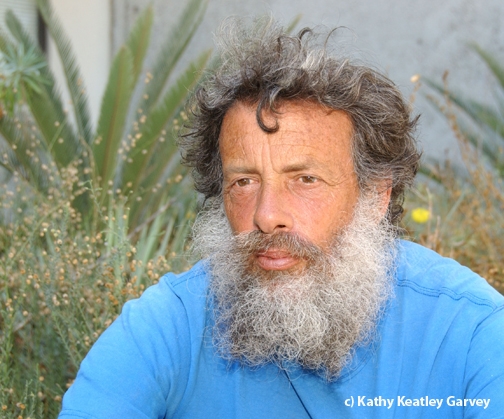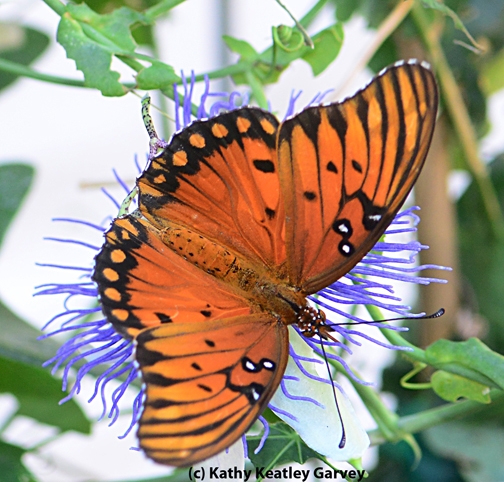
You’re in luck. Butterfly expert Art Shapiro, professor of evolution and ecology at UC Davis, will speak on “Butterflies in Illuminated Manuscripts and Renaissance Art--Homage to Vladimir Nabokov" at the LASER-UC Davis event from 7:25 to 7:50 p.m. on Monday, Dec. 2 in Room 3001, Plant and Environmental Sciences Building.
What’s LASER? The acronym stands for Leonard Art Science Evening Rendezvous. Basically, as the name implies, it integrates art and science.
The event begins at 6:30 p.m. with socializing and networking, continues with four speakers, and ends with a discussion and networking from 9 to 9:30. Organized and moderated by Anna Davidson, a doctoral candidate in the UC Davis Department of Plant Sciences, it is is free and open to all interested persons.
Vladimir Nabokov (1899-1977) was a Russian-born novelist best known for Lolita (1955) but he also made "serious contributions as a lepidopterist and chess composer," according to Wikipedia.
The schedule:
6:30-7 p.m.: Socializing/networking
7-7:25: Amy Franceschini, San Francisco area-based artist, speaking on “Excursions through Domains of Familiarity and Surprise”
7:25-7:50: Arthur Shapiro, professor, UC Davis Department of Evolution and Ecology, “Butterflies in Illuminated Manuscripts and Renaissance Art--Homage to Vladimir Nabokov"
7:50-8:10: BREAK. (During the break anyone in the audience currently working within the intersections of art and science will have 30 seconds to share their work).
8:10-8:35: Justin Schuetz, San Francisco Art Institute faculty member and director of conservation science for National Audubon Society, “Approximating Equations: Visual and Statistical Explorations of Truth”
8:35-9: Mary Anne Kluth, interdisciplinary artist based in San Francisco, “Narratives of Inquiry in a Contemporary Art Practice”
9-9:30: Discussion/Networking
Speaker biosketches:
Amy Franceschini is an artist and founder of the San Francisco-based art and design collective, Futurefarmers. Her work is highly collaborative and usually involves a diverse group of practitioners who come together to make work that responds to a particular time and space. Franceschini creates tactile frameworks for exchange where the logic of a situation can disappear -- where moments of surprise and wonder open the possibility for unexpected encounters and new perspectives on a particular situation. This situational approach emerges as temporary architectural interventions, public programs, choreography, radical journalism and museum exhibitions. Franceschini received her masters of fine arts degree from Stanford University. She is a Guggenheim Fellow and has exhibited at the New York Museum of Modern Art, New York Hall of Sciences and the Solomon R. Guggenheim Museum.
Art Shapiro, distinguished professor of evoluation and ecology at UC Davis, monitors the butterfly population of Central California and posts on his website at http://butterfly.ucdavis.edu/. He works on butterfly biogeography, evolution, and ecology and also does research in Argentina. Shapiro received his bachelor of arts degree in biology from the University of Pennslvania in 1966, and his doctorate in entomology from Cornell University in 1970. Shapiro joined the UC Davis faculty in 1971. He is a fellow of the American Association for the Advancement of Science, California Academy of Sciences, Royal Entomological Society (U.K.) and Explorers Club. He also was selected a Fellow of the Davis Humanities Institute. His credits also include 300 scientific publications (one book, Field Guide to Butterflies of the San Francisco Bay and Sacramento Valley Regions, University of California Press, 2007); and 16 completed doctoral and 15 masters students under his direction. He works on butterfly biogeography, evolution, and ecology.
Justin Schuetz is a visiting faculty member at San Francisco Art Institute; he co-teaches a class on scientific and artistic exploration of biological systems. “Recently I have been using images and text to explore the ideas of a Japanese mathematician whose work has changed how biologists construct statistical models of the world,” Schuetz said. He received his bachelor’s degree in biology and studio art from Bowdoin College, Brunswick, Maine; his doctorate in ecology and evolutionary biology from Cornell University; and his master’s degree in fine arts (photography) from the San Francisco Art Institute. As the director of conservation science for National Audubon Society, he leads a team “that aims to describe relationships between birds, people, and places so that we can better shape conservation outcomes. Much of our recent work has focused on reconstructing responses of birds to historical climate change and forecasting responses to future climate change."
Mary Anne Kluth is an interdisciplinary artist who received her master’s degree in fine arts from the San Francisco Art Institute in 2008 and a bachelor’s of fine arts from California College of Arts in 2005. She says her work explores the nexus of landscape imagery, narrative, and information, and her most recent body of work deals with descriptions of landscape from the 1860s, and contemporary theme park simulations. Kluth recently completed a residence at the Kala Art Institute and exhibited at the Museum of Art and History, Santa Cruz, and the Contemporary Art Center, Las Vegas. Her work has been featured in ARTnews, Beautiful Decay, and Harper's, among other publications. Kluth has written catalog essays, reviews and contributed to various publications, including Art Practical, Artweek, Art Ltd. and Stretcher. She is represented by Gallery Wendi Norris in San Francisco.
For directions to the Plant and Environmental Sciences building, see map. See you there!
Attached Images:

